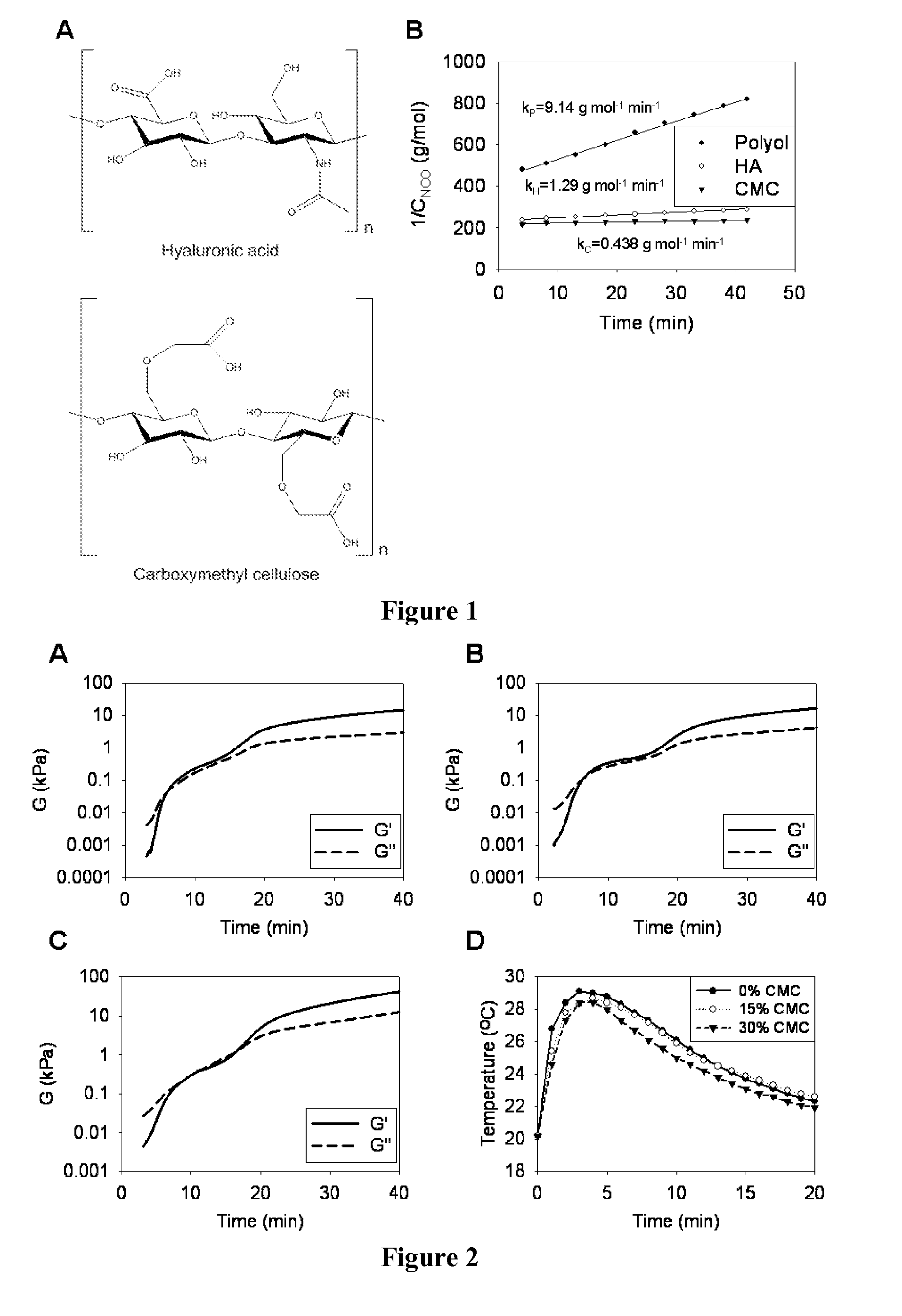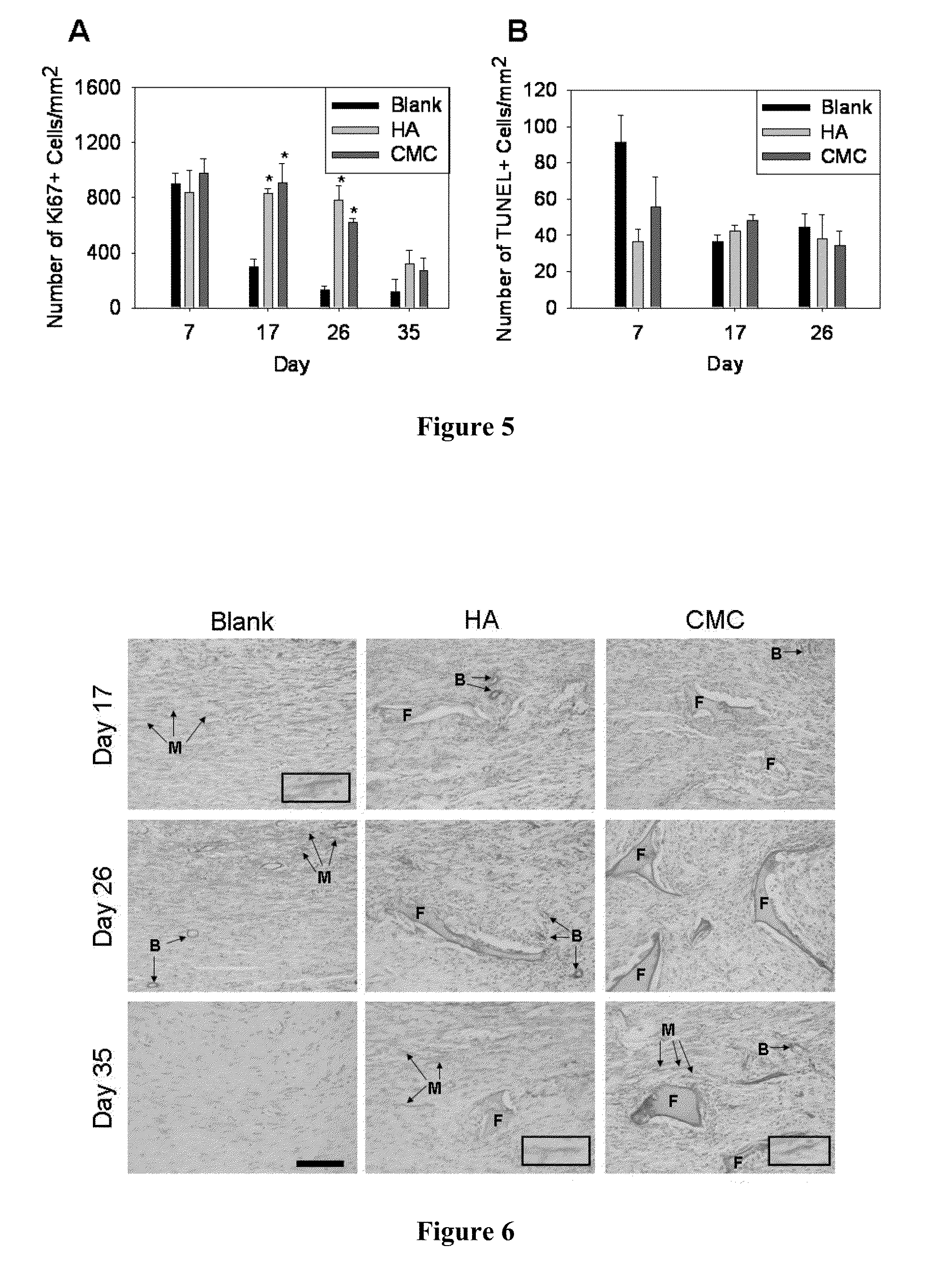Polyurethane Composite for Wound Healing and Methods Thereof
- Summary
- Abstract
- Description
- Claims
- Application Information
AI Technical Summary
Benefits of technology
Problems solved by technology
Method used
Image
Examples
example 1
[0202]This Example describes the preparation and synthesis of PUR foams in accordance with embodiments of the present invention.
[0203]Various materials were used in the preparation and synthesis of the PUR foams. Glycolide and D,L-lactide were purchased from Polysciences (Warrington, Pa.). TEGOAMIN33, a tertiary amine catalyst composed of 33 wt % triethylene diamine (TEDA) in dipropylene glycol, was obtained from Goldschmidt (Hopewell, Va.). Polyethylene glycol (PEG, 200 Da) was supplied by Alfa Aesar (Ward Hill, Mass.). Glycerol and the sodium salts of carboxymethyl cellulose (CMC; 90-kDa) and hyaluronic acid (HA; 1,500-2,200-kDa) were purchased from Acros Organics (Morris Plains, N.J.). Lysine triisocyanate (LTI) was obtained from Kyowa Hakko USA (New York), and stannous octoate catalyst was obtained from Nusil technology (Overland Park, Kans.). All other reagents were purchased from Sigma-Aldrich (St. Louis, Mo.). Prior to use, glycerol and PEG were dried at 10 mm Hg for 3 h at 8...
example 2
[0206]This Example describes the kinetics involved in the synthesis of the PUR scaffolds of Example 1 as well as possible considerations that may be used to optimize a PUR scaffold to meet the limitations of a particular circumstance.
[0207]The reactivities, or the specific reaction rates, for the second order reactions of the LTI-PEG prepolymer with the polyester triol, water, HA, and CMC were measured using attenuated total reflectance fourier transform infrared spectroscopy (ATR-FTIR; Bruker Tensor 27 FTIR, Billerica, Mass.). Prepolymer; TEGOAMIN33 and DMAEE catalysts; and either polyol, HA, or CMC were mixed together for 1 min and then placed in contact with the ATR crystal. The area of the isocyanate peak (wavelength 2150-2350 cm) was monitored as a function of time.
[0208]Looking to FIG. 1B, the results of the reactivity studies are shown. Although not shown in FIG. 1B, water may be the most reactive, and may have a rate constant of 600 g mol−1 min−1. For a certain embodiment, t...
example 3
[0209]This Example describes the rheological properties of PUR scaffolds, such as those of Example 1, during cure. This Example provides insight of how to adjust working and tack-free times for the foams to meet the limitations of particular circumstances. The temperature data indicate that embodiments of foams may be suitable for in vivo applications.
[0210]The cure profiles of the HA and CMC scaffolds were measured using a TA Instruments parallel plate AR 2000ex rheometer operating in dynamic mode with 25 mm disposable aluminum plates (New Castle, Del.). LTI-PEG prepolymer was added to a mixture of hardener and polysaccharide (0, 15, or 30 wt %) and mixed by hand using a spatula for 1 min. The sample was then loaded onto the bottom plate of the rheometer. An oscillation time sweep was run with a controlled strain of 1% and a frequency of 6.28 rad / s in order to obtain the cure profile of each PUR scaffold. The storage modulus (G′) and loss modulus (G″) were determined as a function ...
PUM
| Property | Measurement | Unit |
|---|---|---|
| Pore size | aaaaa | aaaaa |
| Pore size | aaaaa | aaaaa |
| Porosity | aaaaa | aaaaa |
Abstract
Description
Claims
Application Information
 Login to View More
Login to View More - R&D
- Intellectual Property
- Life Sciences
- Materials
- Tech Scout
- Unparalleled Data Quality
- Higher Quality Content
- 60% Fewer Hallucinations
Browse by: Latest US Patents, China's latest patents, Technical Efficacy Thesaurus, Application Domain, Technology Topic, Popular Technical Reports.
© 2025 PatSnap. All rights reserved.Legal|Privacy policy|Modern Slavery Act Transparency Statement|Sitemap|About US| Contact US: help@patsnap.com



